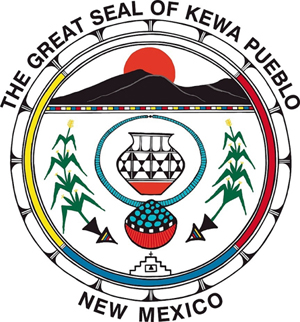 |
Canku Ota
|
 |
|
(Many Paths)
|
||
|
An Online Newsletter
Celebrating Native America
|
||
|
April 1, 2010 - Volume
8 Number 4
|
||
|
|
||
|
Pueblo Returns To
Traditional Name
|
||
|
by Anne Constable -
The (Santa Fe, NM) New Mexican
|
||
|
credits: {credits}
|
|
Santo Domingo quietly becomes 'Kewa'; tribe alters seal, signs and letterhead
Late last year, Santo Domingo Pueblo's tribal council quietly, and unanimously, decided to change the pueblo's name. The traditional community, about halfway between Santa Fe and Albuquerque, is now known as Kewa Pueblo. The name change was disclosed at a meeting of the All Indian Pueblo Council in January, according to the Alvin Warren, secretary of the state Department of Indian Affairs. The name change became more widely known when operators of the Rail Runner Express announced last week that a new train stop opening March 22 will be called Kewa Pueblo Station. But as recently as Saturday, tribal members who sell fine silver and turquoise jewelry under the portal at the Palace of the Governors told a reporter that they didn't know about the switch. Former pueblo Gov. Everett Chavez, who proposed the name change, said Tuesday that Kewa is how the tribe's people refer to themselves privately. "Historically, that's our name," he said. "Everybody knows us as Kewa. It's just going back to our original name." Chavez said the resolution changing the name was fully endorsed by the council. The tribe also hired Zia Graphics in Albuquerque to revise its tribal seal. The new seal still depicts cornstalks, but now also features pottery and jewelry styles for which the pueblo is famous. A mission church, prominent in the original seal, now is referenced in a smaller image at the bottom of the circular design. Chavez said the tribe has printed up new T-shirts and polo shirts (for council members) bearing the new seal. And the tribe is slowly changing signs and the letterhead on its stationery. A café, a fuel company and other businesses were already using the Kewa name. The corporation that manages tribal companies has been reorganized into Kewa Business Enterprises, Chavez said. The Keresan people are considered descendants of people who inhabited the general region in the 1200s. According to the Center for Southwest Research at The University of New Mexico, the pueblo's original name was recorded as Gipuy. The Place Names of New Mexico gives different possible accounts for how it came to be called Santo Domingo. According to one version, Spanish colonial Gov. Don Juan de Oñate gave the Keres pueblo this name, meaning Holy Sunday, because he arrived there on a Sunday. Another story holds that the pueblo was named for St. Dominic, a 13th-century Spanish preacher who founded the Dominican order. Tribal members have said the pueblo, and the mission church on the pueblo, are named for him. One of the better known tribes of the Southwest, Kewa — pronounced KEE-wah — is considered one of New Mexico's most conservative in terms of customs and culture, according to the Indian Pueblo Cultural Center Web site. In fact, the Web site says the tribal government previously had asked that the traditional name not be published. Kewa is not the first pueblo to change its name. In 2005, San Juan Pueblo became Ohkay Owingeh for similar reasons. All tribes have an original or traditional name they use in their own communities, Secretary Warren said, and "certainly the state respects the right of every one of the tribes to self-identify." Chavez said there was no formal announcement of the change and that the tribe has been relying on "word of mouth." He noted that the Spanish also gave various Indian family units Spanish surnames, but that tribal members continued to use their own names privately. Chavez made a point of saying that the renaming is not intended to "demean St. Dominic." This was, he added, "a long-awaited move back to recognition of ourselves. We were Native first and foremost, before Catholicism and the Spaniards." |
|
|
||
|
|
||
| Canku Ota is a free Newsletter celebrating Native America, its traditions and accomplishments . We do not provide subscriber or visitor names to anyone. Some articles presented in Canku Ota may contain copyright material. We have received appropriate permissions for republishing any articles. Material appearing here is distributed without profit or monetary gain to those who have expressed an interest. This is in accordance with Title 17 U.S.C. Section 107. | ||
|
Canku Ota is a copyright ©
2000, 2001, 2002, 2003, 2004, 2005, 2006, 2007, 2008, 2009, 2010
of Vicki Barry and Paul Barry.
|
||
 |
 |
|
|
The "Canku
Ota - A Newsletter Celebrating Native America" web site and
its design is the
|
||
|
Copyright ©
1999, 2000, 2001, 2002, 2003, 2004, 2005,
2006, 2007, 2008, 2009, 2010
of Paul C. Barry.
|
||
|
All Rights Reserved.
|
||
